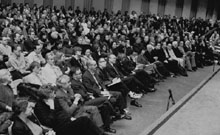 |
| Photo by Dorothy Alexander |
Developing one of the design schemes recently presented for rebuilding Ground Zero is "absolutely doable regardless of who owns what," declared Richard Kahan, former chairman and CEO of lower Manhattan's Battery Park City Authority and former president of New York State Urban Development Corp.
He spoke at a public forum in which the architects and planners of the nine recently presented designs listened to critical appraisals of their schemes (see related story on this Website). The event was held Jan. 7 in New York City, sponsored by Architectural Record magazine and attended by almost 500 architectural luminaries, industry professionals, New York City officials and concerned citizens. Architectural Record and ENR are both units of McGraw-Hill Construction.
Though political, financial and legal obstacles remain, Kahan and others are optimistic about the future of the World Trade Center site. "I reject the idea that any of this is infeasible," he says. However, he acknowledged two problems: "One is that there is no program and the other is that there is no client." An undercurrent of the discussion was that final decisions have not been made about how much space should be devoted to commercial, retail, memorial, cultural or other purposes. It is not even clear who will be the final "client."
But "the architecture genie" has now been let out of the bottle, said Stan Allen, dean of Princeton University's School of Architecture and a member of a team that included Skidmore Owings & Merrill and other architects and artists. That team submitted a scheme that called for a dense collection of towers topped by gardens. Architect Peter Eisenman agreed, saying that the Ground Zero design studies put "New York City and architecture in the world spotlight." Eisenman collaborated on a proposal with fellow New York architects Richard Meier, Charles Gwathmey and Steven Holl. The team's submittal called for an urban plaza defined by towers that form a vertical grid on the site's east and north sides.
How long will the attention last? Panelist Craig Whitaker, an architect and planner, expressed concern: "The public is about to be exhausted and may be excluded from the process in the future."
Andrew Winters, director of design and development with Lower Manhattan Development Corp., disagreed, insisting that the genie cannot be put back in the bottle. Winters pointed out that more than 50,000 people have so far attended an exhibition of the nine schemes that have been on display near the World Trade Center site since late last month. "We've received 3,000 comment cards, 1,000 e-mails and hundreds of letters a day, and the volume is speeding up, not slowing down," he said.
Panelists discussed how officials charged with the redevelopment should proceed. Should one proposal be selected or should the plan draw on the best elements of each? Paul Goldberger, architecture critic of The New Yorker, insists that he does not have a favorite scheme. But he isn't sure if features can be "mixed and matched like a smorgasbord since each proposal has a wholeness and integrity."
Bernard Tschumi, dean of the Graduate School of Architecture, Planning and Preservation at Columbia University, suggested that creating such a scheme would be like making a Cubist collage. But to develop a successful scheme from the best elements of each proposal "you would need the talent of Picasso or Braque," he warns.
Speakers and panelists also raised concerns about the lack of attention being paid to the street level and to the 20- to 30-year time frame it may take to build out the site because current rents in lower Manhattan will not yet support much development. "Public investment should be in transportation, the memorial and amenities, added Robert Yaro, president of the Regional Plan Association. Commercial and retail development should not be subsidized, he maintained.
Public forums will be held to discuss the design schemes on Monday, Jan. 13, and Tuesday, Jan. 14, from 6 to 11 p.m. at Pace University. For more information visit the Websites www.RenewNYC.com or www.LowerManhattan.info.


Post a comment to this article
Report Abusive Comment